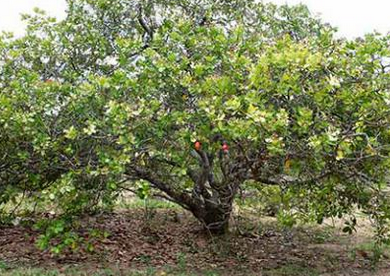The history of the cashew tree (Anacardium occidentale) spans centuries and continents, evolving from its native Brazil to its modern role as a globally traded commodity. Here’s a detailed look at its historical journey:

- Native origin: Brazil
- Global spread: Portuguese influence, Africa, India
- Commercial expansion: India, Africa
- Modern cultivation: India, Brazil, Vietnam, West Africa
- Cultural significance: Culinary uses, toxic shell
- Economic uses: Wood, gum, resin
1. Native Origin in Brazil
The cashew tree is indigenous to the tropical region of northeastern Brazil, where it was initially cultivated by indigenous peoples for its seeds and the “cashew apple.” The tree thrived in the dry, tropical climates of Brazil, especially in coastal regions, and the seeds were a staple in local diets. Cashews were consumed not only as food but also for their medicinal properties.
2. Portuguese Influence and Spread to Africa and India
During the 16th century, Portuguese explorers and missionaries played a pivotal role in spreading the cashew tree beyond Brazil. They introduced the cashew to their colonies in East Africa, particularly in Mozambique, and to India, where the tree found fertile ground, especially in coastal areas with tropical climates. This led to the cashew’s establishment in India as a major cash crop, and India became one of the largest producers of cashews.
3. Commercial Expansion in India and Africa
Over time, cashew cultivation expanded significantly in India, with commercial cashew plantations flourishing in the southern states of Kerala, Karnataka, Goa, and Tamil Nadu. The Portuguese initially introduced the tree to control soil erosion near the coast, but by the 18th century, the value of the cashew nut was recognized, and its cultivation became more focused on economic purposes.
In Africa, cashew trees were widely planted, particularly in Mozambique and Tanzania, which remain important cashew-growing regions today. Cashew farming became vital to local economies, with the nuts being exported to global markets.

4. Modern Cultivation and Global Trade
Today, India and Brazil are among the top producers of cashew nuts, along with Vietnam, which has emerged as a major player in cashew processing and exports. West Africa, particularly Ivory Coast, Nigeria, and Benin, has also become a significant exporter of cashew nuts in recent decades.
5. Cultural and Culinary Significance
The cashew nut is highly valued in South and Southeast Asian cuisine, particularly in India where it is a key ingredient in various dishes, including curries and sweets. The nut’s distinctive flavor and rich oil content make it a popular choice in vegetarian and non-vegetarian dishes alike.
In Western countries, cashews are mainly consumed as a snack or used in confectionery, with demand for premium-quality nuts driving exports from producing nations.
6. Toxic Shell and Related Plants
A unique feature of cashews is their close relation to poison ivy and poison sumac, which makes the shell toxic. The cashew shell contains a resin known as urushiol, the same irritant found in poison ivy, which can cause severe skin reactions. Due to this, cashews are never sold in their shells, and processing them requires special handling to avoid exposure to these toxins. This resin is also used in the production of insecticides, plastics, and even traditional medicines.
7. Cashew Apple and Local Use
Apart from the seed (cashew nut), the cashew apple—a fleshy, pear-shaped fruit—is also used in various local products, particularly in Brazil and India. It is consumed fresh or made into beverages, jams, and jellies. In Goa, a region in India, cashew apples are used to produce feni, a locally famous alcoholic beverage.
Economic and Industrial Uses
Cashew wood is used for practical items like shipping crates, boats, and charcoal. Additionally, the gum derived from the tree is similar to gum arabic, and the resin inside the shells has various industrial applications, including insecticides and traditional medicine.
Conclusion
The cashew tree’s journey from Brazil to becoming a globally cultivated crop in India, Africa, and Southeast Asia highlights its adaptability and commercial importance. With wide-ranging uses from cuisine to industrial applications, the cashew has secured its place in both local economies and global trade.
